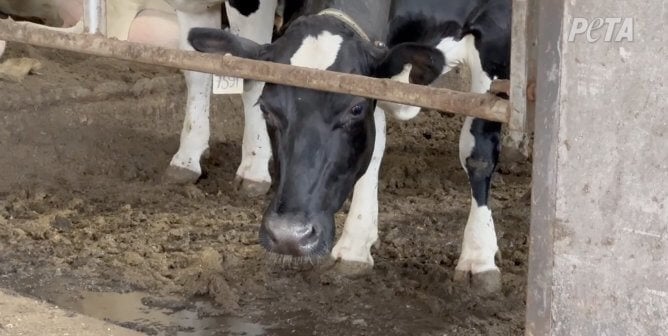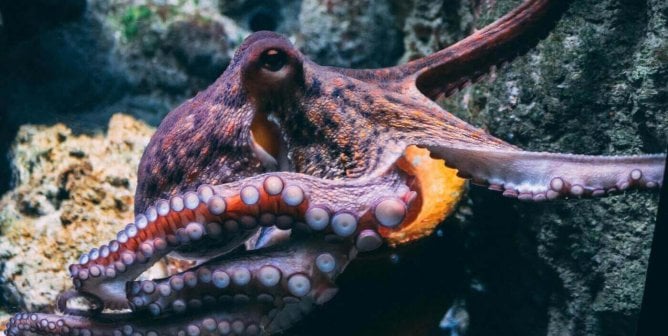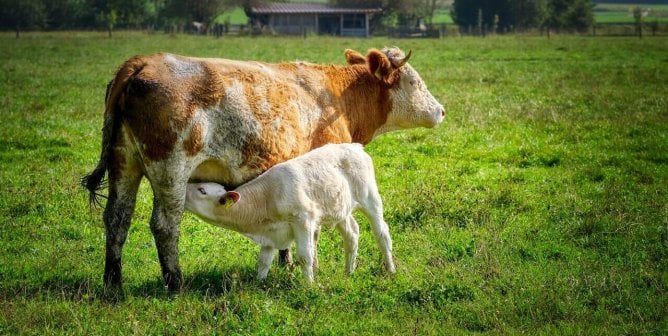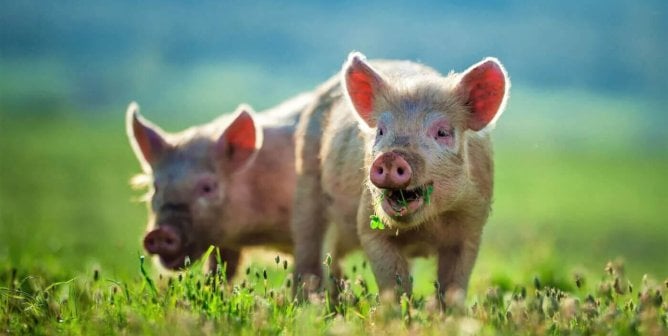The Honey Industry
Although there were 3,500 native bee species of bees pollinating the flowers and food crops of North America when European settlers landed on its shores in the 17th century, the colonists were interested only in their Old World honeybees’ wax and honey. They imported the insects, and by the mid-1800s, both feral and domesticated colonies of honeybees were scattered all over the United States.1 As a result of disease, pesticides, and climate changes, the honeybee population has been nearly decimated, but since the demand for the bees’ honey and other products remains high, these tiny animals are raised by industries, much like chickens, pigs, and cows are.
The Complex Lives of Bees
A honeybee hive consists of tens of thousands of bees, each with his or her own mission that is determined by the bee’s sex and age as well as by the time of year. Each hive usually has one queen, hundreds of drones, and thousands of workers. Queens can live for as long as five years, while other bees have life spans ranging from a few weeks to six months.2
Worker bees are responsible for feeding the brood, caring for the queen, building comb, foraging for nectar and pollen, and cleaning, ventilating, and guarding the hive. The drones serve the queen, who is responsible for reproduction. She lays about 250,000 eggs each year—and as many as 1 million over the course of her lifetime.3
When a new queen is about to be born, the old queen and half the hive leave their old home and set up in a new place that scouting worker bees have found.4
As the temperature drops in the winter, the bees cluster around the queen and the young, using their body heat to keep the temperature inside the hive steady at around 93 degrees F.5
A Language All Their Own
Bees have a unique and complex form of communication based on sight, motion, and scent that scientists and scholars are working to understand.6 Bees alert other members of their hive to food, new hive locations, and conditions within their hive (such as nectar supply) through intricate “dance” movements.7
Studies have shown that bees are capable of abstract thinking as well as distinguishing their family members from other bees in the hive, using visual cues to map their travels, and finding a previously used food supply, even when their home has been moved.8,9,10
“Bees are self-aware, they’re sentient, and they possibly have a primitive form of consciousness,” says scientist Stephen Buchmann. “They solve problems and can think. Bees may even have a primitive form of subjective experiences.”11
And similar to the way that smells can invoke powerful memories in for humans, they can also trigger memories in bees, such as memories of where the best food can be found.12
Why Bees Need to Keep Their Honey
Plants produce nectar to attract pollinators (bees, butterflies, bats, and other mammals), who are necessary for successful plant reproduction. Bees collect and use nectar to make honey, which provides vital nourishment for them, especially during the winter. Since nectar contains a lot of water, bees have to work to dry it out, and they add enzymes from their own bodies to convert it into food and prevent it from going bad.13 A single worker bee will produce a little more than one teaspoonful of honey during her lifetime.14
Honeybees Do Not Pollinate as Well as Native Bees
Approximately one out of every four mouthfuls of food or drink that humans consume is made possible by pollinators—insects, birds, and mammals pollinate about 75 percent of all food crops.15
Industrial beekeepers want consumers to believe that honey is just a byproduct of the necessary pollination provided by honeybees, but honeybees are not as good at pollinating as many truly wild bees, such as bumblebees and carpenter and digger bees. Native bees are active earlier in the spring, both males and females pollinate, and they are not affected by stressors such as colony collapse disorder.16 But because most species of native bees hibernate for as many as 11 months out of the year and do not live in large colonies, they do not produce massive amounts of honey, and the little that they do produce is not worth the effort required to steal it from them.17,18
So although native bees are more effective pollinators, farmers continue to rely on honeybees for commercial pollination. In California, for example, more than two million honeybee colonies are trucked in to pollinate trees for the state’s multibillion dollar almond industry; Billions of bees die as a result, from both pesticides and disease.19
Manipulating Nature
Profiting from honey requires the manipulation and exploitation of the insects’ desire to live and protect their hive. Like other factory-farmed animals, honeybees are victims of unnatural living conditions, genetic manipulation, and stressful transportation.
The familiar white box that serves as a beehive has been around since the mid-1850s and was created so that beekeepers could move the hives from place to place. The New York Times reported that bees have been “moved from shapes that accommodated their own geometry to flat-topped tenements, sentenced to life in file cabinets.”20
Since “swarming” (the division of the hive upon the birth of a new queen) can cause a decline in honey production, beekeepers do what they can to prevent it, including clipping the wings of a queen.21,22 Queens are artificially inseminated using drones, who are killed in the process.23 Commercial beekeepers also “trick” queens into laying more eggs by adding wax cells to the hive that are larger than those that worker bees would normally build.24
What You Can Do
Avoid honey, beeswax, propolis, royal jelly, and other products that come from bees. Vegan lip balms and candles are readily available. Visit CaringConsumer.com for a list of companies that don’t use animal products. Agave nectar, rice syrup, molasses, sorghum, barley malt, maple syrup, and dried fruit or fruit concentrates can be used to replace honey in recipes. Visit PETA.org to order a free vegetarian/vegan starter kit that contains information about compassionate eating choices.
References
1Sue Hubbell, “Trouble With Honeybees,” Natural History 106 (1997): 32-42.
2Mid-Atlantic Apiculture Research and Extension Consortium, “The Colony and Its Organization,” Fundamentals of Beekeeping, accessed 2 Feb. 2020.
3Mid-Atlantic Apiculture Research and Extension Consortium.
4Norbert M. Kauffeld, “Seasonal Cycle of Activities in Honey Bee Colonies,” Beekeeping in the United States, U.S. Department of Agriculture, Agricultural Handbook Number 335 (1980): 30-2.
5Kauffeld.
6Fred C. Dyer, “The Biology of the Dance Language,” Annual Review of Entomology 47 (2002): 917-49.
7Carl Anderson and Francis L.W. Ratnieks, “Worker Allocation in Insect Societies: Coordination of Nectar Foragers and Nectar Receivers in Honey Bee (Apis mellifera) Colonies,” Behavioral Ecology and Sociobiology (1999): 73-81.
8Martin Giurfa et al., “The Concepts of ‘Sameness’ and ‘Difference’ in an Insect,” Nature 19 Apr. 2001.
9Fred C. Dyer, “Spatial Memory and Navigation by Honeybees on the Scale of the Foraging Range,” The Journal of Experimental Biology 199 (1996): 147-54.
10Gérard Arnold et al., “Kin Recognition in Honeybees,” Nature 8 Feb. 1996.
11Annette McGivney, “‘Bees are sentient’: inside the stunning brains of nature’s hardest workers,” The Guardian 2 Apr. 2023
12Judith Reinhard et al., “Scent-Triggered Navigation in Honeybees,” Nature 29 Jan. 2004.
13Maryann Frazier, “Honey-Here’s To Your Health,” Beeaware: Notes & News on Bees & Beekeeping, Mid-Atlantic Apiculture Research and Extension Consortium, Jan. 2003.
14Canadian Honey Council “How To Make A Pound of Honey,” 2018.
15U.S. Geological Service, “The Buzz on Native Bees,” 15 June 2015.
16Krisy Gashler, “Native Bees Are Better Pollinators, More Plentiful Than Honeybees, Finds Entomologist,” Cornell Chronicle 24 Oct. 2011.
17Lane Greer, “Alternative Pollinators: Native Bees,” Appropriate Technology Transfer for Rural Areas, U.S. Department of Agriculture, Aug. 1999.
18Greer.
19Agricultural Statistics Board, “Honey,” U.S. Department of Agriculture, 16 May. 2019.
20McGivney.
21Anne Raver, “Bees Buzz a Path to His Hive,” The New York Times 31 May 2001.
22Sara DeBerry et al., “Swarm Control for Managed Beehives,” University of Florida, July 2019.
23Michael Cavanagh, “Taking the Sting Out of A Bee’s Sex Life,” ABC 16 June 2016.
24Raver.








